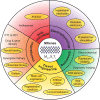Latest advances on MXenes in biomedical research and health care
- PMID: 36846314
- PMCID: PMC9943034
- DOI: 10.1557/s43577-023-00480-0
Latest advances on MXenes in biomedical research and health care
Abstract
The unique combination of physical and chemical properties of MXenes has propelled a growing number of applications in biomedicine and healthcare. The expanding library of MXenes with tunable properties is paving the way for high-performance, application-specific MXene-based sensing and therapeutic platforms. In this article, we highlight the emerging biomedical applications of MXenes with specific emphasis on bioelectronics, biosensors, tissue engineering, and therapeutics. We present examples of MXenes and their composites enabling novel technological platforms and therapeutic strategies, and elucidate potential avenues for further developments. Finally, we discuss the materials, manufacturing, and regulatory challenges that need to be synergistically addressed for the clinical translation of MXene-based biomedical technologies.
Keywords: Bioelectronics; Biosensing; Clinical translation; MXene; Therapeutics; Tissue engineering.
© The Author(s), under exclusive License to the Materials Research Society 2023, Springer Nature or its licensor (e.g. a society or other partner) holds exclusive rights to this article under a publishing agreement with the author(s) or other rightsholder(s); author self-archiving of the accepted manuscript version of this article is solely governed by the terms of such publishing agreement and applicable law.
Conflict of interest statement
Conflict of interestF.V. is a co-inventor on two following pending international patent applications related to MXene bioelectronics: PCT/US2020/055147; PCT/US2018/051084.
Figures



Similar articles
-
MXene in the lens of biomedical engineering: synthesis, applications and future outlook.Biomed Eng Online. 2021 Apr 1;20(1):33. doi: 10.1186/s12938-021-00873-9. Biomed Eng Online. 2021. PMID: 33794899 Free PMC article. Review.
-
MXene hydrogels: fundamentals and applications.Chem Soc Rev. 2020 Oct 19;49(20):7229-7251. doi: 10.1039/d0cs00022a. Chem Soc Rev. 2020. PMID: 32936169
-
Biomedical engineering of two-dimensional MXenes.Adv Drug Deliv Rev. 2022 May;184:114178. doi: 10.1016/j.addr.2022.114178. Epub 2022 Feb 26. Adv Drug Deliv Rev. 2022. PMID: 35231544 Review.
-
Recent advances using MXenes in biomedical applications.Mater Horiz. 2024 Feb 19;11(4):876-902. doi: 10.1039/d3mh01588b. Mater Horiz. 2024. PMID: 38175543 Review.
-
MXenes as emerging materials to repair electroactive tissues and organs.Bioact Mater. 2025 Mar 3;48:583-608. doi: 10.1016/j.bioactmat.2025.01.035. eCollection 2025 Jun. Bioact Mater. 2025. PMID: 40123746 Free PMC article. Review.
Cited by
-
Induction of Chirality in MXene Nanosheets and Derived Quantum Dots: Chiral Mixed-Low-Dimensional Ti3C2Tx Biomaterials as Potential Agricultural Biostimulants for Enhancing Plant Tolerance to Different Abiotic Stresses.Small. 2025 May;21(21):e2500654. doi: 10.1002/smll.202500654. Epub 2025 Apr 3. Small. 2025. PMID: 40176740 Free PMC article.
-
Effects of Etching and Delamination on Biocompatibility of Ti-Based MXenes.ACS Appl Mater Interfaces. 2025 Aug 27;17(34):47919-47937. doi: 10.1021/acsami.5c08807. Epub 2025 Aug 18. ACS Appl Mater Interfaces. 2025. PMID: 40825140 Free PMC article.
-
Bioelectronic Therapeutics: A Revolutionary Medical Practice in Health Care.Bioelectricity. 2025 Mar 18;7(1):2-28. doi: 10.1089/bioe.2024.0039. eCollection 2025 Mar. Bioelectricity. 2025. PMID: 40342937 Review.
-
Soft, Multifunctional MXene-Coated Fiber Microelectrodes for Biointerfacing.ACS Nano. 2024 Aug 27;18(34):23217-23231. doi: 10.1021/acsnano.4c05797. Epub 2024 Aug 14. ACS Nano. 2024. PMID: 39141004 Free PMC article.
-
Shared Experiences With Guidewire Application in Chronic Total Occlusion: Technological Advances and Clinical Implications.Rev Cardiovasc Med. 2025 Jul 23;26(7):33469. doi: 10.31083/RCM33469. eCollection 2025 Jul. Rev Cardiovasc Med. 2025. PMID: 40776950 Free PMC article. Review.
References
-
- Rajan AC, Mishra A, Satsangi S, Vaish R, Mizuseki H, Lee K-R, Singh AK. Chem. Mater. 2018;30:4031. doi: 10.1021/acs.chemmater.8b00686. - DOI
Publication types
Grants and funding
LinkOut - more resources
Full Text Sources
